#1st commando battalion
Explore tagged Tumblr posts
Text
Another Chinese Company is building an Automotive Factory in Thailand; Indonesia is inviting China to invest in their Water Infrastructure; Chinese Troops arrive in Singapore for a Joint Military Training; Another Chinese Company is investing Usd 500 million to build a Factory in Vietnam, and an All-Police Band goes Viral in Malaysia for singing a Chinese Song
#china#thailand#indonesia#singapore#vietnam#malaysia#south east asia sea#chery international#electric vehicle ev#basuki hadimuljono#ministry of public works and public housing pupr#nusantara#3rd singapore division#1st commando battalion#74th army group#peoples liberation army pla#exercise cooperation 2023#shandong haohua tire#binh phuoc#hai kuo tian kong#penang#north east police department nepd
1 note
·
View note
Text

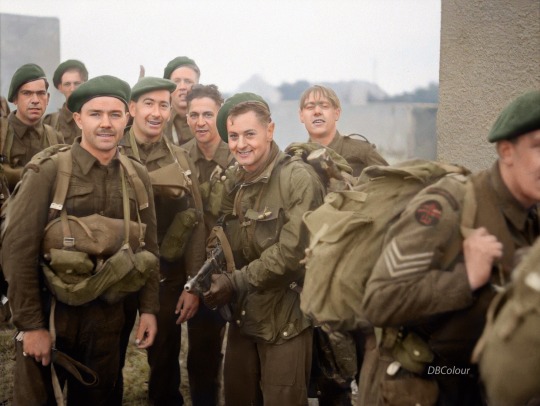






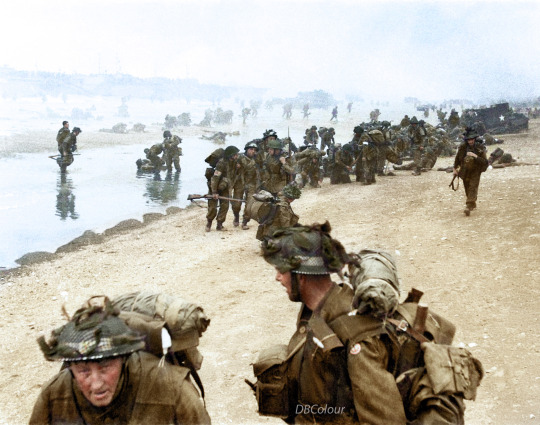

To commemorate the anniversary of D-Day, a short thread of photos colourised by DBColour (Colourising History on Facebook). Descriptions run from top-to-bottom.
Piper Bill Millin, seen here landing on Sword Beach with his bagpipes with Lord Lovat’s Commandos of 1st Special Service Brigade. IWM B 5103.
Commandos of 1st Special Service Brigade after landing on Queen Red beach, Sword area, 6 June 1944. British Airborne troops smile from the door of their Horsa glider as they prepare to fly out as part of the second drop on Normandy on the night of 6th June 1944. LCI(L) 135 of the 2nd Canadian (262nd RN) Flotilla carrying personnel of the North Nova Scotia Highlanders and the Highland Light Infantry of Canada en route to France on D-Day, 6 June 1944. (Library and Archives Canada Photo, MIKAN Nº. 3205043) Film still from the D-Day landings showing commandos aboard a landing craft on their approach to Sword Beach, 6 June 1944.
LCA (Landing Craft Assault) containing soldiers from the Winnipeg Rifles head for the Normandy Juno beach - June 6, 1944.
Commandos approach Sword Beach in a Landing Craft Infantry (LCI). Ahead, the beach is crowded with tanks and vehicles of 27th Armoured Brigade and 79th Armoured Division.
Troops of 3rd Infantry Division on Queen Red beach, Sword area, circa 0845 hrs, 6 June 1944. In the foreground are sappers of 84 Field Company Royal Engineers. Behind them, medical orderlies of 8 Field Ambulance, RAMC, can be seen assisting wounded men.
A Horsa glider near the Caen Canal bridge at Benouville, 8 June 1944. No. 91 (PF800), carried Major John Howard and Lieutenant Den Brotheridge of No.1 Platoon, 'D' Co., 2nd Battalion Oxfordshire and Buckinghamshire Light Infantry in the early hours of D-Day. © IWM B 5232
#d-day#d-day anniversary#ww2#world war 2#second world war#history#military history#british army#lest we forget#remembrance
304 notes
·
View notes
Text













On March 1st 1910, David Niven, actor and author, was born.
Despite his lifelong claim to have been born a Scot, in Kirriemuir, he was actually born in Belgravia, but let’s not take that away from, who wouldn’t rather be Scottish than English? 😉
The actors Donald Crisp and James Robertson Justice were two others who although pinned there colours to Scotland, were actually born in England. Niven though served in the Highland Light Infantry, (despite asking for any regiment but the HLI) in the early 1930s.
Many of you out there will be of Scottish descent either researched, known or simply because you have a Scottish name, one of my friends has a broad English accent but was born and brought up near Inverness and a lot of people up the north of Scotland claim to be “more” Scottish than those in the south, what a load of nonsense that is.
Niven wanted to be Scottish and that’s good enough for me and the same goes for any of you out there. Being Scottish, as well as being born here can be a state of mind in my humble opinion. Niven’s Scottish heritage came from his paternal grandfather, David Graham Niven, he was from St Martin’s, a village in Perthshire, and was killed in WW1 during the Gallipoli campaign.
He resigned his commission in the army in 1933 and made his way to the USA, where, still chasing the Scottish connection, spendingt time as a whisky salesman, then joining a rodeo, before arriving in Hollywood in the mid 1930’s. Early appearances in films include Barbary Coast and Mutiny on the Bounty, but blink and you’ll miss him. His first starring role was in Thank You, Jeeves! as Bertie Wooster
Other films include A Matter of Life and Death, Around the World in 80 Days, The Guns of Navarone and The Pink Panther. My favourite was The Bishops Wife and he played Bonnie Prince Charlie in the film of the same name.
At the outbreak of World War II Niven returned home and rejoined the army, the Government at the time advised actors to stay in Holywood at the time, and he was alone in refusing this advice, he was assigned to a motor training battalion. He wanted something more exciting, however, and transferred into the Commandos, his training was at Inverailort House in the Highlands. On his return to Hollywood afterwards the Americans awarded him with Legion of Merit, the highest military award that can be given to a non US citizen. Niven never talked much about his time during the war, but did see action a few days after D Day and at Battle of the Bulge.
He is also well known as the author of the bestselling autobiography, The Moon’s a Balloon. His career fluctuated in the 50’s but he endured that and came back bigger than ever, he played Bond in the original Casino Royale, but his greatest achievement was winning an Oscar in the film Separate Tables, becoming the only person to win an academy award while hosting the ceremony!
So David Niven maybe not “Scottish” in the true sense of the word, but certainly Proud to be seen as a Scot.
28 notes
·
View notes
Text
Books of 2023

Book 30 of 2023
Title: To the Limit: An Air Cav Huey Pilot in Vietnam Authors: Tom A. Johnson ISBN: 9780451222183 Tags: AC-47 Spooky, B-52 Stratofortress, CH-47 Chinook, CH-54 Tarhe, EOD, LAO Laos, LAO Laotian Civil War (1959-1975), LAO Operation Commando Hunt (1968-1972) (Laotian Civil War) (Vietnam War), LAO Operation Shining Brass / Prairie Fire / Phu Dong (1965-1975) (Laotian Civil War) (Vietnam War), O-1 Bird Dog, OH-13 Sioux, OH-23 Raven, OV-1 Mohawk, Pathfinders, UH-1 Huey, US Secretary of Defense Robert McNamara, US USA 11th Aviation Group, US USA 11th Aviation Support Group, US USA 12th Cavalry Regiment, US USA 12th Cavalry Regiment - 2/12, US USA 15th Medical Det. - Mercy, US USA 173rd Airborne Brigade - Sky Soldiers, US USA 1st Cavalry Division, US USA 1st Cavalry Division - 11th Pathfinder Co., US USA 20th Aerial Rocket Artillery Bn, US USA 20th Aerial Rocket Artillery Bn - 2/20 - Blue Max, US USA 227th Assault Helicopter Bn, US USA 227th Assault Helicopter Bn - C/227, US USA 228th Assault Helicopter Bn, US USA 229th Assault Helicopter Bn, US USA 229th Assault Helicopter Bn - A/229 - Bandit, US USA 229th Assault Helicopter Bn - A/229 - Python, US USA 229th Assault Helicopter Bn - B/229 - Preachers, US USA 229th Assault Helicopter Bn - D/229 - Smiling Tiger, US USA 229th Assault Helicopter Bn - D/229 - Tom Cat, US USA 478th Aviation Co, US USA 7th Cavalry Regiment, US USA 7th Cavalry Regiment - 1/7 - C Troop, US USA 7th Cavalry Regiment - 2/7, US USA 8th Cavalry Regiment, US USA 8th Cavalry Regiment - 1/8, US USA 8th Cavalry Regiment - 1/8 - B Troop, US USA 8th Cavalry Regiment - 1/8 - C Troop, US USA 8th Cavalry Regiment - 2/8, US USA 8th Engineer Bn, US USA 9th Cavalry Regiment, US USA 9th Cavalry Regiment - 1/9, US USA 9th Cavalry Regiment - 1/9 - C Troop, US USA Fort Polk LA, US USA Fort Rucker AL, US USA Fort Rucker AL - Hanchey Army Air Field, US USA Fort Wolters TX (1963-1973), US USA General Creighton Abrams, US USA General John "Jack" Norton, US USA General John Tolson, US USA LRRP Team (Vietnam War), US USA United States Army, US USA USSF Green Berets, US USA USSF Special Forces, US USMC 3rd MarDiv, US USMC United States Marine Corps, US USN Construction Battalions (Seabees), US USN SEALS, US USN United States Navy, USA 5th SFG, VNM 1968 Tet Offensive (1968) (Vietnam War), VNM A Louie Airstrip, VNM A Shau Valley, VNM An Khe, VNM An Lao Valley, VNM Ba To Airstrip, VNM Battle of Hue City (1968) (Tet Offensive) (Vietnam War), VNM Battle of Khe Sanh (1968) (Tet Offensive) (Vietnam War), VNM Bong Son, VNM Bong Son Pass, VNM Bong Son River, VNM Camp Evans (Vietnam War), VNM Camp Radcliff (Vietnam War), VNM Cay Giep Mountains, VNM Central Highlands, VNM Command and Control North/FOB-4 (Vietnam War), VNM Da Nang, VNM Dak To, VNM Dam Tra-O Lake, VNM Dia Dong, VNM Dong Ha, VNM DRV NVA 22nd Regiment, VNM DRV NVA 325C Division, VNM DRV NVA 325C Division - 7th Bn, VNM DRV NVA 325C Division - 9th Bn, VNM DRV NVA 3rd Division, VNM DRV NVA North Vietnamese Army, VNM DRV VC Viet Cong, VNM Highway 1, VNM Highway 19, VNM Hill 450, VNM Hill 814 (LZ Peanuts) (Vietnam War), VNM Ho Chi Minh Trail (Vietnam War), VNM Hon Kon (Hong Kong Mountain) / (Signal Mountain), VNM Hue, VNM Hue Phu Bai, VNM I Corps (Vietnam War), VNM II Corps (Vietnam War), VNM LZ Bird (Vietnam War), VNM LZ Dog (Vietnam War), VNM LZ El Paso (Vietnam War), VNM LZ English (Vietnam War), VNM LZ Geronimo (Vietnam War), VNM LZ Laramie (Vietnam War), VNM LZ Pat (Vietnam War), VNM LZ Pepper (Vietnam War), VNM LZ Sally (Vietnam War), VNM LZ Sandra (Vietnam War), VNM LZ Sharon (Vietnam War), VNM LZ Signal Hill (Vietnam War), VNM LZ Stud (Vietnam War), VNM LZ Thor (Vietnam War), VNM LZ Tiger (Vietnam War), VNM LZ Tom (Vietnam War), VNM LZ Two Bits (Vietnam War), VNM LZ Vicki (Vietnam War), VNM Marble Mountain, VNM Nui Mot (The Rockpile), VNM Operation Arc Light (1965-1973) (Vietnam War), VNM Operation Delaware / Lam Son 216 (1968) (Vietnam War), VNM Operation Jeb Stuart (1968) (Vietnam War), VNM Operation Pegasus / Lam Son 207 (1968) (Vietnam War), VNM Operation Pershing (1967-1968) (Vietnam War), VNM Phan Rang Air Base, VNM Phu Cat Mountains, VNM Quang Tri, VNM Quang Tri Province, VNM Qui Nhon, VNM RVN ARVN Army of the Republic of Vietnam, VNM Song Ba, VNM Song Chal Truc, VNM Song Re, VNM Song Re Valley, VNM Tam Quan, VNM US MACV Military Assistance Command Vietnam (Vietnam War), VNM US MACVSOG (1964-1972) (Vietnam War), VNM US UH-1 Huey Firefly Missions (Vietnam War), VNM US USAF Phu Cat Air Base (Vietnam War), VNM US USMC DHCB Dong Ha Combat Base (Vietnam War), VNM US USMC KSCB Khe Sanh Combat Base (Vietnam War), VNM US USMC MMAF Marble Mountain Air Facility, VNM US USMC QTCB Quang Tri Combat Base (Vietnam War), VNM Vietnam, VNM Vietnam War (1955-1975) Rating: ★★★★ (4 Stars) Subject: Books.Military.20th-21st Century.Asia.Vietnam War.Aviation.US Army.Helos.Slicks, Books.Military.20th-21st Century.Asia.Vietnam War.Laotian Civil War.Aviation.Helos
Description: **The riveting memoir of a Vietnam War helicopter pilot. “When you step into a Huey with Tom Johnson, you’re in for the real thing. No one has previously captured the Vietnam helicopter experience with such gripping authority.”—Robert F. Dorr, author of Chopper ** From June 1967 to June 1968, Tom Johnson accumulated an astonishing 1,600 flying hours piloting the UH-1 “Iroquois”—better known as the “Huey”—as part of the famous First Air Cavalry Division. His battalion was one of the most decorated units of the Vietnam War, and helped redefine modern warfare. Johnson’s riveting memoir takes us into key battles and rescue missions, including those for Hue and Khe Sanh. In harrowing detail, he tells of being shot down in the battle of A Shau Valley, of surviving enemy attacks during the Tet Offensive, and of a death-defying nighttime river rescue, in which only the bare feet of soldiers hanging off the Huey’s skids kept the helicopter from plunging under water. From dangerous missions to narrow escapes, Johnson’s memoir vividly captures the adrenaline rush and the horror of war, and takes you on a ride you’ll never forget.
#Books#Ebooks#Booklr#Bookblr#Vietnam War#Laotian Civil War#MACVSOG#US Army#1st Air Cav#1st Cavalry Division#UH-1 huey#Tet Offensive#Special Forces#History#Military History#NonFiction
4 notes
·
View notes
Text
Events 1.31 (after 1930)
1942 – World War II: Allied forces are defeated by the Japanese at the Battle of Malaya and retreat to Singapore. 1943 – World War II: German field marshal Friedrich Paulus surrenders to the Soviets at Stalingrad, followed two days later by the remainder of his Sixth Army, ending one of the war's fiercest battles. 1944 – World War II: American forces land on Kwajalein Atoll and other islands in the Japanese-held Marshall Islands. 1944 – World War II: During the Anzio campaign, the 1st Ranger Battalion (Darby's Rangers) is destroyed behind enemy lines in a heavily outnumbered encounter at Battle of Cisterna, Italy. 1945 – US Army private Eddie Slovik is executed for desertion, the first such execution of an American soldier since the Civil War. 1945 – World War II: About 3,000 inmates from the Stutthof concentration camp are forcibly marched into the Baltic Sea at Palmnicken (now Yantarny, Russia) and executed. 1945 – World War II: The end of fighting in the Battle of Hill 170 during the Burma Campaign, in which the British 3 Commando Brigade repulsed a Japanese counterattack on their positions and precipitated a general retirement from the Arakan Peninsula. 1946 – Cold War: Yugoslavia's new constitution, modeling that of the Soviet Union, establishes six constituent republics (Bosnia and Herzegovina, Croatia, Macedonia, Montenegro, Serbia and Slovenia). 1946 – The Democratic Republic of Vietnam introduces the đồng to replace the French Indochinese piastre at par. 1949 – These Are My Children, the first television daytime soap opera, is broadcast by the NBC station in Chicago, United States. 1951 – United Nations Security Council Resolution 90 relating to the Korean War is adopted. 1958 – Cold War: Space Race: The first successful American satellite detects the Van Allen radiation belt. 1961 – Project Mercury: Mercury-Redstone 2: The chimpanzee Ham travels into outer space. 1966 – The Soviet Union launches the unmanned Luna 9 spacecraft as part of the Luna program. 1968 – Vietnam War: Viet Cong guerrillas attack the United States embassy in Saigon, and other attacks, in the early morning hours, later grouped together as the Tet Offensive. 1971 – Apollo program: Apollo 14: Astronauts Alan Shepard, Stuart Roosa, and Edgar Mitchell, aboard a Saturn V, lift off for a mission to the Fra Mauro Highlands on the Moon. 1971 – The Winter Soldier Investigation, organized by the Vietnam Veterans Against the War to publicize alleged war crimes and atrocities by Americans and allies in Vietnam, begins in Detroit. 1978 – The Crown of St. Stephen (also known as the Holy Crown of Hungary) goes on public display after being returned to Hungary from the United States, where it was held after World War II. 1988 – Doug Williams becomes the first African American quarterback to play in a Super Bowl and leads the Washington Redskins to victory in Super Bowl XXII. 2001 – In the Netherlands, a Scottish court convicts Libyan Abdelbaset al-Megrahi and acquits another Libyan citizen for their part in the bombing of Pan Am Flight 103 over Lockerbie, Scotland in 1988. 2003 – The Waterfall rail accident occurs near Waterfall, New South Wales, Australia. 2007 – Emergency officials in Boston mistakenly identified battery-powered LED placards depicting characters from Aqua Teen Hunger Force as Improvised explosive devices (IEDs), causing a panic. 2009 – At least 113 people are killed in Kenya and over 200 injured following an oil spillage ignition in Molo, days after a massive fire at a Nakumatt supermarket in Nairobi killed at least 25 people. 2019 – Abdullah of Pahang is sworn in as the 16th Yang di-Pertuan Agong of Malaysia. 2020 – The United Kingdom's membership within the European Union ceases in accordance with Article 50, after 47 years of being a member state.[ 2022 – Sue Gray, a senior civil servant in the United Kingdom, publishes an initial version of her report on the Downing Street Partygate controversy. 2023 – The last Boeing 747, the first wide-body airliner, is delivered.
0 notes
Text
Royal Thai Army and US Army Special Forces Conclude Exercise Balance Torch 24-3
In a display of enhanced joint capabilities, the Royal Thai Army (RTA) and the United States Army (US Army) successfully concluded Exercise Balance Torch 24-3 on February 15, 2024, following the opening ceremony on January 26, 2024. The culminating event featured a parachute jump from a Lockheed Martin MC-130J Commando II special operations transport aircraft of the United States Air Force (USAF) at Khok Sung Public Place, Taku Subdistrict, Pak Thong Chai District, Wang Nakhon Ratchasima. This parachuting field, strategically located between the Special Warfare Command, Royal Thai Army Hospital, and the 1st Special Forces Group (Airborne) of the US Army, commonly known as the "Green Berets," witnessed the collaboration between the Thai side, represented by the 2nd Infantry Battalion, 3rd Infantry Regiment, 3rd Infantry Division from the 2nd Army Region, and their U.S. counterparts.
In a display of enhanced joint capabilities, the Royal Thai Army (RTA) and the United States Army (US Army) successfully concluded Exercise Balance Torch 24-3 on February 15, 2024, following the opening ceremony on January 26, 2024. The culminating event featured a parachute jump from a Lockheed Martin MC-130J Commando II special operations transport aircraft of the United States Air Force (USAF)…

View On WordPress
0 notes
Text
Five steps of Wikipedia for Friday, 5th January 2024
Welcome, chào mừng, hoş geldiniz, أهلا بك (ahlan bika) 🤗 Five steps of Wikipedia from "Faisal Al-Essa" to "1st Paratroopers Battalion (Belgium)". 🪜👣

Start page 👣🏁: Faisal Al-Essa "Faisal Al-Essa (Arabic: في��ل العيسى; born January 1, 1982), Saudi Arabian actor...."
Step 1️⃣ 👣: Arabic "Arabic (اَلْعَرَبِيَّة, al-ʿarabiyyah [alʕaraˈbijːah] ; عَرَبِيّ, ʿarabī [ˈʕarabiː] or [ʕaraˈbij]) is a Semitic language spoken primarily across the Arab world. Having emerged in the first millennium BC, it is named after the Arab people; the term "Arab" was initially used to describe those living..."

Image licensed under CC BY-SA 3.0? by Keteracel at English Wikipedia
Step 2️⃣ 👣: Abbasid Caliphate "The Abbasid Caliphate ( or ; Arabic: الْخِلَافَةُ الْعَبَّاسِيَّة, romanized: al-Khilāfah al-ʿAbbāsiyyah) or Abbasid Empire was the third caliphate to succeed the Islamic prophet Muhammad. It was founded by a dynasty descended from Muhammad's uncle, Abbas ibn Abd al-Muttalib (566–653 CE), from whom..."

Image by Ec.Domnowall
Step 3️⃣ 👣: 2003 invasion of Iraq "The United States-led invasion of the Republic of Iraq was the first stage of the Iraq War. The invasion phase began on 19 March 2003 (air) and 20 March 2003 (ground) and lasted just over one month, including 26 days of major combat operations, in which a combined force of troops from the United..."

Image by Lance Cpl. Brian L. Wickliffe, U.S. Marine Corps
Step 4️⃣ 👣: 10th Special Forces Group (United States) "The 10th Special Forces Group (Airborne) (10th SFG (A), or 10th Group) is an active duty United States Army Special Forces (SF) Group. 10th Group is designed to deploy and execute nine doctrinal missions: unconventional warfare (UW), foreign internal defense (FID), direct action (DA),..."
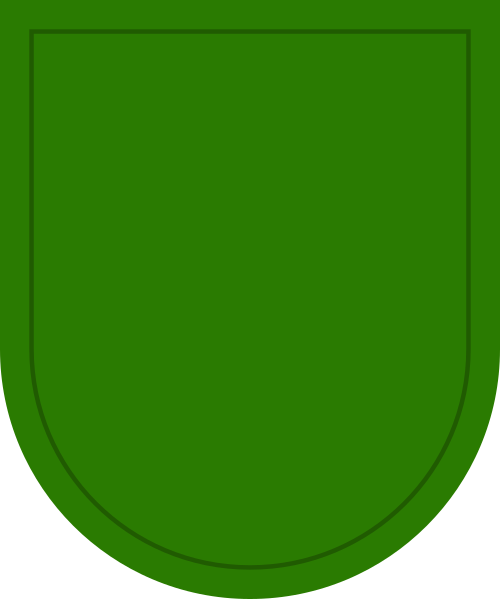
Image by US Army
Step 5️⃣ 👣: 1st Paratroopers Battalion (Belgium) "The 1st Paratroopers Battalion (French: 1er Bataillon Parachutiste, Dutch: 1 Bataljon Parachutisten) or 1 PARA was a military formation of the Belgian Army and part of the Para-Commando Brigade from 1946 to 2011. Its regimental traditions, including its badge and motto, were heavily influenced by..."

Image
0 notes
Text
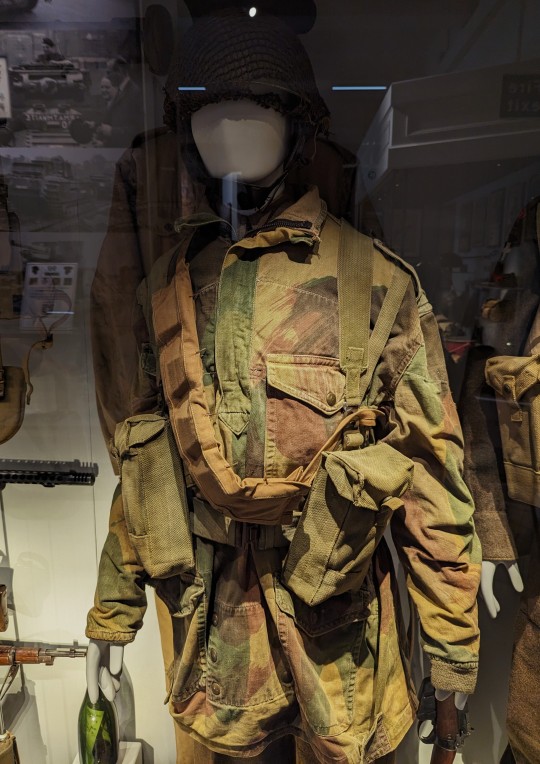
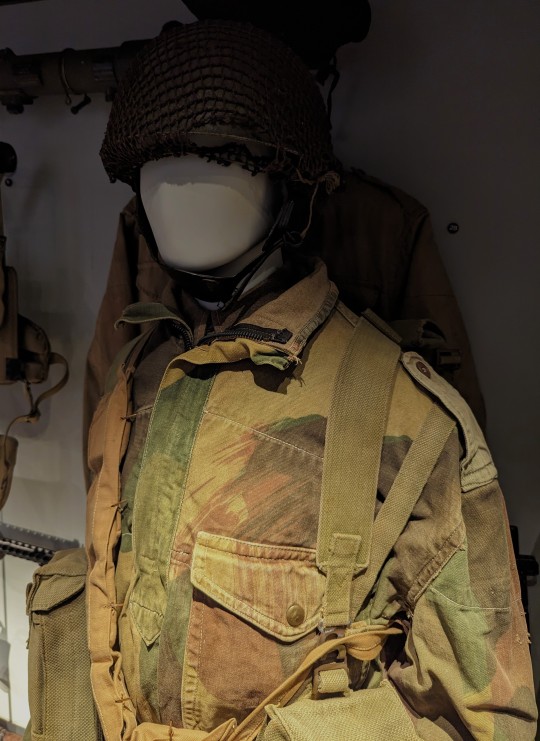

Officer's Uniform of the 1st (Airborne) Battalion The Border Regiment from the British Empire dated to 1944 on display at the Cumbria Museum of Military Life in Carlisle, England
After seeing how effective the Nazis airborne operations were during the invasion of France the British War Office was directed to create an airborne force. In 1940 the No. 2 Commando assumed parachute duties and after some success other regiments were also changed including 1st Battalion The Border Regiment which was re trained into the 1st (Airborne) Battalion The Border Regiment. The airborne regiments wore the Helmet Steel Airborne Troop (HSAT) instead fo the more common Brodie helmet used by British and Commonwealth forces. As well as that they used one of the first pieces of camaflaged uniform in the British Army, the Denison Smock. It proved so effective, other special operations units used the uniform as well.
They fought at the Battle of Arnhem, part of the vanguard of the Allied Operation Market Garden. There they were instructed to Arnhem road bridge in the Netherlands alongside other airborne battalions, the Glider Pilot Regiment and the 1st Independent Parachute Brigade (Poland). The battle was a failure for the allies as the small Allied force was not relieved in time and overwhelmed by the fascist forces.
Photographs taken by myself 2023
#uniform#fashion#british empire#england#english#20th century#second world war#military history#cumbria museum of military life#carlisle#barbucomedie
1 note
·
View note
Text

Capitaine Jean Graziani, born in Algeria in the same town Albert Camus was born. Joined the US Army at the age of 16 in 1942 after allied forces landed in Algeria before being kicked out because of his age. Joined the French resistance, shipping him to Scotland to be trained as an SAS demolition specialist before being parachuted in occupied France to delay the German retreat of 1944, destroying bridges, railways and sabotaging a hundred phone lines. He will serve in the 3rd BCCP paratrooper regiment in Indochina, leading a commando unit behind enemy lines before being captured by the Viet Minh during an attempt to rescue an encircle column of the 1st Foreign Parachute Battalion. He will stay 4 years in a prisoner camp despite two escapes attempts, his last enabling hime to sail 60km along the Song Gain river on a makeshift raft. He would later be assigned to a counter-insurgency unit in Algeria where he will be killed on January 6, 1959 after being hit with submachine gun fire in the guts during an operation in Kabylie. He had enough time to give his watch to a good friend of him during his helicopter transfer. The journey of this shock troop officer pictures very well the journey of many French officers during the post WW2 colonial wars and their ambiguity. Often pulled from the ranks of the resistance to fight tyranny, they ressorted to the same techniques to maintain France's grasp on its colonial empire. Many of them ended in jail or as outcasts, torn and disabused by their experience of violence mixed with politics and the slow decay of their empire and youth ideals.
#french#soldier#capitaine#indochina#beautifuldestinations#colonial wars#history#war#paratrooper#special forces#algeria
36 notes
·
View notes
Text
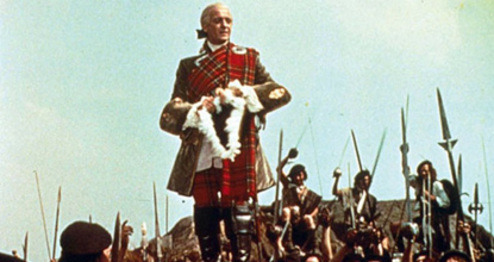


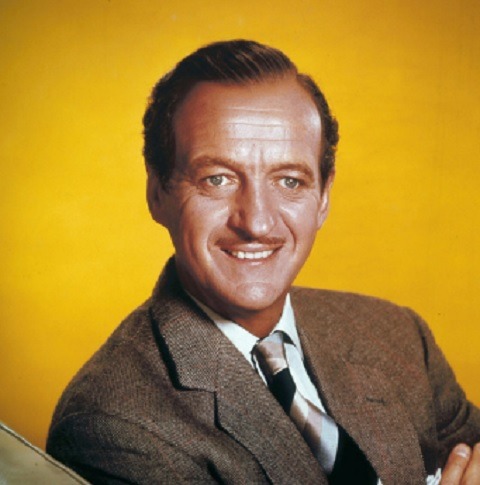
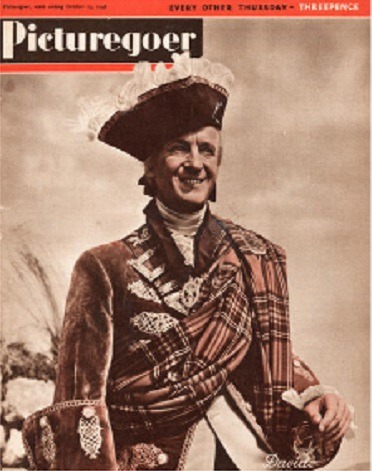

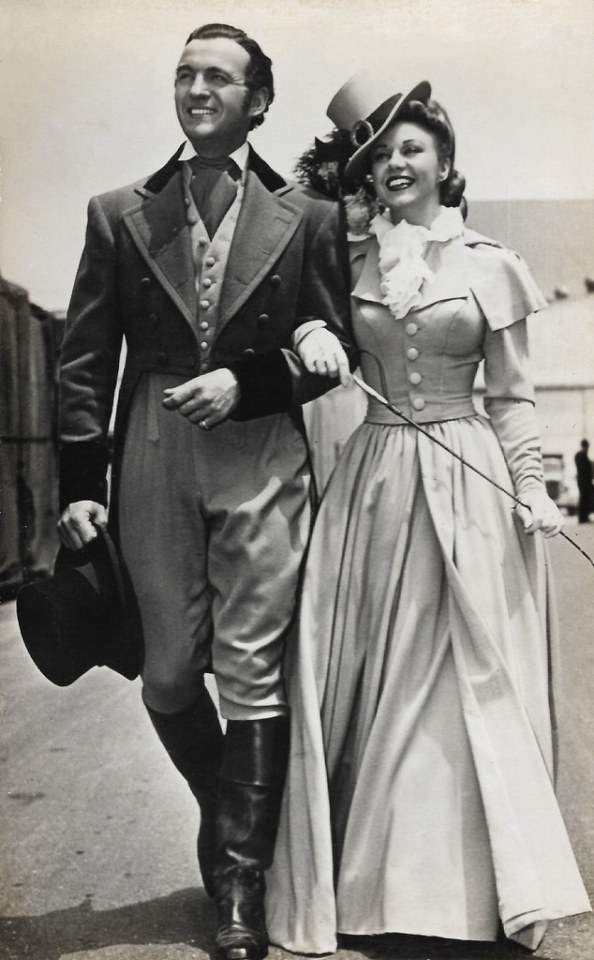
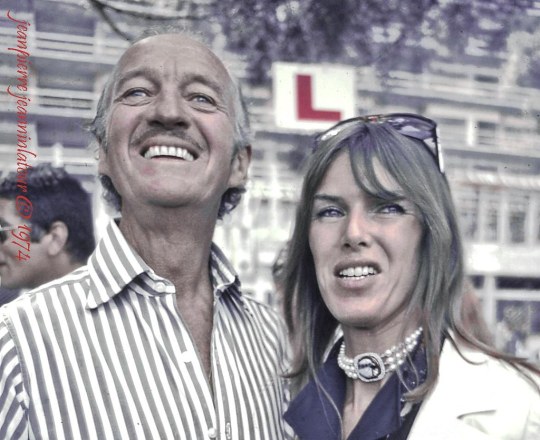

On March 1st 1910, David Niven, actor and author, was born.
Despite his lifelong claim to have been born a Scot, in Kirriemuir, he was actually born in Belgravia, but let’s not take that away from, who wouldn’t rather be Scottish than English? 😉 The actors Donald Crisp and James Robertson Justice were two others who although pinned there colours to Scotland, were actually born in England. Niven though served in the Highland Light Infantry, (despite asking for any regiment but the HLI) in the early 1930s.
Many of you out there will be of Scottish descent either researched, known or simply because you have a Scottish name, one of my friends has a broad English accent but was born and brought up near Inverness and a lot of people up the north of Scotland claim to be “more” Scottish than those in the south, what a load of nonsense that is.
Niven wanted to be Scottish and that’s good enough for me and the same goes for any of you out there. Being Scottish, as well as being born here can be a state of mind in my humble opinion. Niven’s Scottish heritage came from his paternal grandfather, David Graham Niven, he was from St Martin’s, a village in Perthshire, and was killed in WW1 during the Gallipoli campaign.
He resigned his commission in the army in 1933 and made his way to the USA, where, still chasing the Scottish connection, spendingt time as a whisky salesman, then joining a rodeo, before arriving in Hollywood in the mid 1930’s. Early appearances in films include Barbary Coast and Mutiny on the Bounty, but blink and you’ll miss him. His first starring role was in Thank You, Jeeves! as Bertie Wooster
Other films include A Matter of Life and Death, Around the World in 80 Days, The Guns of Navarone and The Pink Panther. My favourite was The Bishops Wife and he played Bonnie Prince Charlie in the film of the same name.
At the outbreak of World War II Niven returned home and rejoined the army, the Government at the time advised actors to stay in Holywood at the time, and he was alone in refusing this advice, he was assigned to a motor training battalion. He wanted something more exciting, however, and transferred into the Commandos, his training was at Inverailort House in the Highlands. On his return to Hollywood afterwards the Americans awarded him with Legion of Merit, the highest military award that can be given to a non US citizen. Niven never talked much about his time during the war, but did see action a few days after D Day and at Battle of the Bulge.
He is also well known as the author of the bestselling autobiography, The Moon’s a Balloon. His career fluctuated in the 50’s but he endured that and came back bigger than ever, he played Bond in the original Casino Royale, but his greatest achievement was winning an Oscar in the film Separate Tables, becoming the only person to win an academy award while hosting the ceremony!
So David Niven maybe not “Scottish” in the true sense of the word, but certainly Proud to be seen as a Scot.
14 notes
·
View notes
Text
Clonetober #22 Captain Gregor Laughter
CC-5576 (short for CC-5576-39) aka “Gregor” has always been a great soldier and a GREAT CLONE COMMANDO CAPTAIN when he was serving with his Clone Brothers in his “Foxtrot Group” as SGT 1ST CLASS of the 212 ATTACK BATTALION. He always likes to make his Clone Brothers and others laugh BUT there are 2 Clone Brothers that are hard to make them laugh. The Clones are CC-3636 aka “Commander “Wolffe” and CC-1010 aka “Commander Fox”. I’m going to do some role play with jokes in this story.
Gregor: HEY WOLFFE! HEY FOX! I have a joke for you guys.
Fox: Let me guess. You are also trying to see if you can make us laugh. Right?
Gregor: Yes. WAIT! How do you….
Wolffe: We know because Fives, Hardcase, Anakin, and Wrecker have been trying to see who can make us laugh. Cody and Rex are also doing it.
Gregor: WHAT?! Fives told me that it was just me vs him.
Fox: Well. It looks like Hardcase found out and told others. So far none of them have been able to make us laugh. Do you think you can? You have 3 chances.
Gregor: YES SIR!
Fox: Alright. Tell us a joke.
Gregor: OK. What do you call an ant who fights crime?
Wolffe: A vigilANTe.
Gregor: A vigil..WAIT?! How do you know…..
Fox: Fives told us that one. OK. That’s number 1. What else do you have?
Gregor: OK. Here’s a great one! What do you call a pirate droid?
Wolffe: Arr-2 D2.
Gregor: A…..NO! WHO TOLD YOU THAT ONE?
Fox: Hardcase then Wrecker said it to us earlier before Hardcase came to tell us. That’s 2. You have 1 left.
Gregor: OK. Let me think…I GOT ONE. Why did the…..
Wolffe: The chicken crossed the road. To get to the other side.
Gregor: To…..UHHH! How come I can’t make you guys laugh?
Fox: Because we heard that one from Anakin. That was 3. Sorry Brother. Better luck next time.
Just before Gregor was about to leave, Senator Riyo Chuchi storms in the BASE and yells at Fox.
Riyo: YOU ARE IN TROUBLE MISTER!
Fox: WHAT?! (trying to not chuckle) What did I do?
Riyo: You didn’t put any of your night clothes in the hamper. OH. NO. You DIDN’T SEE THAT YOU threw YOUR DIRTY UNDERWEAR on ME when you were trying to throw it into the dirty hamper because you WERE in a HURRY
Wolffe: (hold his breath and trying not to laugh)
Fox: I’m so s…..
Riyo: OH NO. NO! You DIDN’T stop there!! When I was getting ready, YOU LEFT YOUR HOLOPAD IN THE BATHROOM! Cody tried to call you which made me jump and made me MESS UP MY MAKE-UP!
Wolffe and Fox: (still trying to hold in their laughter)
Riyo: Also, YOU FORGOT TO GET GAS FOR THE OTHER VEHICLE! I was SO LATE that I had to call for a TAXI but the guy who gave me a ride to the SENATE BUILDING but I DIDN’T KNOW THAT HE DROVE A CONVERTIBLE. HE ACCIDENTLY HIT A BUTTON THAT MADE THE CAR ROOF GO DOWN. He was trying to get it back up but it was STUCK! I RODE IN THAT VEHICLE IN THE RAIN!
After Riyo had said that, Fox and Wolffe couldn’t hold in their laughter. They just laughed SO HARD that Wolffe ALMOST PEED HIMSELF! Fox was rolling on the flooring and just laughing. Gregor was shocked that RIYO was able to make THEM LAUGH. I forgot to mention that Riyo had a big LONG LIPSTICK SMEARED that went from her lips to HALFWAY toward her RIGHT EYE. Her mascara was also SMEARED due to the rain and she was soaking WET! Looks like she WON THE BET and it also looks like FOX will be sleeping on the couch tonight.
Thank you for reading my story. Please let me know how you liked it and if you want me to tag you in some of my stories.
@twistedstitcher27 @laz-laz-ace-pilot @etainskirata @criivik @ahsokatano-thetogruta @catawampuscorner @goateeculture @megantron13 @kixthecondomfairy @crazymeee1997
2 notes
·
View notes
Photo

25 OCT 1983 -OPERATION URGENT FURY (GRENADA) After a coup within the People's Revolutionary Government on the small Caribbean island of Grenada -with suspected Cuban involvement, and about 700 Americans attending medical schools there, the United States launched a hasty invasion, Operation URGENT FURY. At 0500 on 25 Oct 1983, soldiers of the 1st and 2d Battalions (Ranger), 75th Infantry began an airborne operation to secure Point Salinas Airport against anti-aircraft fire. Once on the ground, they removed obstacles People's Revolutionary Army (PRA) and Cuban defenders had placed to block the runway. Assisted by Air Force AC-13O gunships, the Rangers secured the airfield by 0735, neutralized enemy anti-aircraft weapons, and captured many Cubans. Almost simultaneously, a company of the 2d Battalion, 8th Marines landed by helicopter on the east coast and secured Pearls Airport against light resistance. In the meantime, lightly armed Navy Sea Air Land (SEAL) commandos secured the British Governor General, Sir Paul, at his residence in St. George's, but were surrounded by RPA troops with armored vehicles. The SEALs resisted with Navy, Marine and Air Force air support until a force of marines with tanks and amphibious vehicles that landed at Grand Mal Bay linked up with them. The Rangers then moved to evacuate American students and neutralize enemy resistance while two brigades of the 82d Airborne Division arrived to join the fight. Operations continued against decreasing resistance over the next several days as Grenadian civilians welcomed the American troops as liberators. When they were withdrawn on 15 December, nearly 7,000 American military personnel, mostly Army, had served on Grenada at some point, of whom about 2,500 had engaged 1,500 PRA soldiers and 700 armed Cuban defenders in combat. Posted @withregram • @armyhistory #Grenada #UrgentFury #Armyhistory #USArmy #thisdayinarmyhistory (at Middle Tennessee Area) https://www.instagram.com/p/CVc5G97AVNw/?utm_medium=tumblr
2 notes
·
View notes
Text

• D-Day: Sword Beach
Sword, commonly known as Sword Beach, was the code name given to one of the five main landing areas along the Normandy coast during the initial assault phase, of Operation Overlord, the Allied invasion of German-occupied France that commenced on June 6th, 1944.
Following the Fall of France in 1940, British Prime Minister Winston Churchill vowed to return to continental Europe and liberate the Nazi German-occupied nations. The Western Allies agreed to open a Second Front in northern Europe in 1942 to aid the Soviet Union. However, with resources for an invasion lacking, it was postponed. The decision to postpone the invasion was due to wanting to see the Battle of the Atlantic to its closure, the lack of landing craft, invading Sicily in July 1943, and Italy in September following the defeat of Axis forces in North Africa in May 1943 resulted in the postponement of any assault on northern Europe till 1944.
Having succeeded in opening up an offensive front in southern Europe, gaining valuable experience in amphibious assaults and inland fighting, Allied planners returned to the plans to invade Northern France. Now scheduled for June 5th, 1944, the beaches of Normandy were selected as landing sites, with a zone of operations extending from the Cotentin Peninsula to Caen. Operation Overlord called for the British Second Army to assault between the River Orne and Port en Bessin, capture the German-occupied city of Caen and form a front line from Caumont-l'Éventé to the south-east of Caen, in order to acquire airfields and protect the left flank of the United States First Army while it captured Cherbourg. Overlord would constitute the largest amphibious operation in military history. After delays, due to both logistical difficulties and poor weather, the D-Day of Overlord was moved to June 6th, 1944.
The coastline of Normandy was divided into seventeen sectors, with codenames using a spelling alphabet, from Able, west of Omaha, to Roger on the east flank of Sword. Eight further sectors were added when the invasion was extended to include Utah on the Cotentin Peninsula. The Anglo-Canadian assault landings on D-Day were to be carried out by the British Second Army, under Lieutenant General Miles Dempsey. The Second Army's I Corps, commanded by Lieutenant General John Crocker, was assigned to take Sword. 6th Beach Group was deployed to assist the troops and landing craft landing on Sword and to develop the beach maintenance area. Sword stretched about 5 miles (8.0 km) from Saint-Aubin-sur-Mer in the west to the mouth of the River Orne in the east. It was further sub-divided into four landing sectors; from west to east these sectors were 'Oboe' (from Saint-Aubin-sur-Mer to Luc-sur-Mer), 'Peter' (from Luc-sur-Mer to Lion-sur-Mer), 'Queen' (from Lion-sur-Mer to La Brèche d'Hermanville), and finally 'Roger' (from La Brèche d'Hermanville to Ouistreham).
The sector chosen for the assault was the 1.8 miles (2.9 km) wide 'White' and 'Red' beaches of 'Queen' sector, as shallow reefs blocked access to the other sectors. Two infantry battalions supported by DD tanks would lead the assault followed up by the commandos and the rest of the division; the landing was due to start at 07:25 hours; the division would be the last assault division to land. Under the command of Field Marshals Erwin Rommel and Gerd von Rundstedt, the defences of the Atlantic Wall were heavily upgraded; in the first six months of 1944, 1.2 million tons of steel and 17.3 million cubic yards of concrete were laid. The coast of northern France was also studded with four million antitank and anti-personnel mines, and 500,000 beach obstacles. On and behind Sword, twenty strongpoints, including several artillery batteries, were constructed. The coastline was littered with wooden stakes, mines, hedgehogs, and Dragon’s teeth, while along the top of the beach, the Germans had constructed a network of trenches, gun pits, mortar pits, and machine gun nests. Barbed wire surrounded these positions and lined the beach.
The assault on Sword began at about 03:00 with the aerial and naval bombardment of German coastal defences and artillery sites. The landing was to be concentrated on Queen Red and Queen White in front of Hermanville-sur-Mer, other approaches having proven impassable due to shoals. At 07:25, the first units set off for the beach. These were the amphibious DD tanks of the 13th/18th Hussars; they were followed closely by the 8th Infantry Brigade, and by Royal Engineers in AVREs. The engineers set to work clearing mines and obstacles under a steady hail of small arms fire and artillery fire from Périers Ridge just south of Hermanville. Resistance on the beach was initially fairly strong, with wrecked vehicles piling up and casualties mounting; however, with most of their armoured vehicles successfully landed, the British were able to quickly secure the immediate area. By 09:30 the engineers had cleared seven of the eight exits from the beach, allowing the inland advance to begin.
British and French commandos encountered tough resistance in the seaside town of Ouistreham, on Sword's eastern extremity, but were able to clear it of enemy strongpoints. By 13:00, the 1st Special Service Brigade had reached the bridges on the River Orne and the Caen Canal, linking up with paratroops of the 6th Airborne Division, who were holding the bridges, after earlier disabling German gun batteries in a fierce night-time battle earlier. On the western flank of Sword, commandos of the 4th Special Service Brigade moved out to secure Lion-sur-Mer and effect a link up with Canadian forces at Juno Beach, but encountered strong resistance and were pinned down by heavy fire for several hours. Meanwhile, around the main landing area, the men of the 3rd Infantry Division had secured Hermanville-sur-Mer by 10:00, but were finding tougher going as they slowly fought their way up Périers Ridge and moved inland. It was gradually becoming apparent that the British would not be able to make the hook-up with the 3rd Canadian Infantry Division necessary to protect its right flank in an immediate assault on Caen. Troops of the King's Shropshire Light Infantry continued down the Hermanville-Caen road, reaching Biéville-Beuville, close to Caen, but were supported by only a few self-propelled guns, their flanks exposed.
The 21st Panzer Division, with its formidable inventory of some 127 Panzer IV tanks, was intended for use as a rapid response force; on the morning of June 6th, however, its commander, Generalmajor Edgar Feuchtinger, was in Paris, and Rommel was in Germany. The division was unable to finalize orders and preparations for a counterattack until late in the day. At about 17:00, two thrusts were launched, east and west of the River Orne. Taking advantage of the gap between the Sword and Juno sectors, elements of the 192nd Panzergrenadier Regiment were able to reach the coast at Lion-sur-Mer by 8:00 p.m.; however, with few flak units and very little support from the Luftwaffe, they too suffered devastating losses to Allied aircraft. When 250 Gliders of the British 6th Airlanding Brigade overflew their positions, on their way to reinforce the Orne bridgehead in Operation Mallard, the Germans, believing they were about to be cut off, retired.
By the end of D-Day, 28,845 men of I Corps had come ashore across Sword. British losses in the Sword area amounted to 683 men. The British and Canadians were able to link up and resume the drive on Caen the following day, but three days into the invasion, the advance was halted. On June 7th, Operation Perch, a pincer attack by the 51st (Highland) Infantry Division and XXX Corps was launched to encircle Caen from the east and west flanks. The 21st Panzer Division halted the 51st Division advance and the XXX Corps attack resulted in the Battle of Villers-Bocage and the withdrawal of the leading elements of the 7th Armoured Division.
#second world war#world war 2#world war ii#d day#sword beach#june 6 1944#june 6 2020#anniversary#military history#british history#normandy#unsung heroes
56 notes
·
View notes
Photo

Who Dares Wins
The British Special Air Service (SAS) is one of the best counter insurgency forces in the world today, however until the 1980s very little was known about the SAS.
The concept of the SAS was the brainchild of David Sterling, in World War II, 1941, while he was recovering from a parachute accident in hosptal. The idea was to create a desert raiding force, that worked in teams of 4 or 5 highly trained and motivated soldiers. Stirling designed the force to conduct raids and sabotage far behind enemy lines in the desert.
Stirling’s fledgling special forces unit operated in conjunction with the existing Long Range Desert Group. Stirling (formerly of No.8 Commando) looked for recruits with rugged individualism and initiative and recruited specialists from Layforce and other units. Stirling received the permission that he required, and took 100 men, most already commondo's, and gave them hard training in endurance and weapons. The name "Special Air Service" was already in use as a deception.

Their first mission, parachuting behind enemy lines in support of General Sir Claude Auchinleck's attack in November 1941, was a disaster. Only 22 out of 62 troopers reached the rendezvous.
Stirling still managed to organise another attack against the German airfields at Aqedabia, Site and Agheila, this time transported by the LRDG. They destroyed 61 enemy aircraft without a single casualty. 1st SAS earned regimental status and Stirling's brother Bill began to organise a second regiment, 2 SAS.
During the desert war the SAS performed many successful and daring long range insertion missions and destroyed aircraft and fuel depots. Their success contributed towards Hitler issuing his Kommandobefehl order to execute all captured Commandos.
When the Germans stepped up security, the SAS switched to hit-and-run tactics. They used jeeps armed with Vickers K machine guns and used tracer ammunition to ignite fuel and aircraft. They took part in Operation Torch.
David Stirling was captured by the Italians in January 1943 and he spent the rest of the war as a prisoner of war in Colditz Castle. His brother Bill Stirling and 'Paddy' Blair Mayne took command of the SAS.

The SAS were used in the invasion of Italy. At the toe of Italy they took the first prisoners of the campaign before heading deeper into Italy. At one point four groups were active deep behind enemy lines laying waste to airfields, attacking convoys and derailing trains.
Towards the end of the campaign Italian guerrillas and escaped Russian prisoners were enlisted into an "Allied SAS Battalion" which struck at Kesselring's main lines of communications.
In 1945 Major Farran made one of the most effective raids of the war. His force raided the German Fifth Corps headquarters burning the buildings to the ground and killing the General and some of his staff.

Prior to the Normandy Invasion, SAS men were inserted into France as 4-man teams to help maquisards of the French Resistance. In a reversal of their by now customary tactics, they often travelled during the day, when Allied fighter bombers drove enemy traffic off the roads and then ambushed enemy troops moving in convoy under the cover of darkness. In Operation Houndsmith, 144 SAS men parachuted with jeeps and supplies into Dijon, France.
During and after D-Day they continued their raids against fuel depots, communications centres and railways. They did suffer casualties—at one stage the Germans executed 24 SAS soldiers and a US Army Air Force pilot.
At the end of the war, the SAS hunted down SS and Gestapo officers. By that time the SAS had been expanded to five regiments, including two French and one Belgian.
**British SAS soldiers on patrol in North Africa in 1943.
146 notes
·
View notes
Photo
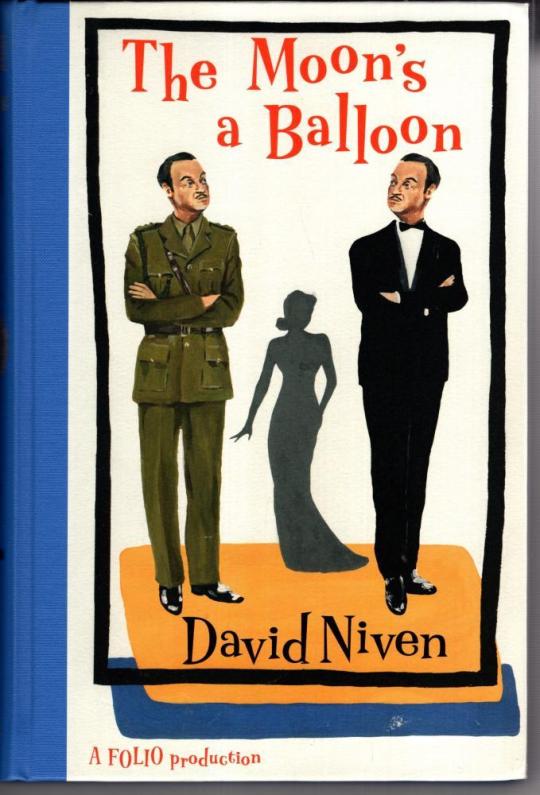
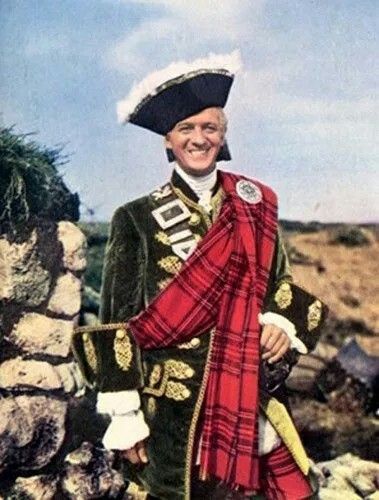




On March 1st 1910, David Niven, actor and author, was born.
Despite his lifelong claim to have been born a Scot, in Kirriemuir, he was actually born in Belgravia, but let’s not take that away from, who wouldn’t rather be Scottish than English? ;) The actors Donald Crisp and James Robertson Justice were two others who although pinned there colours to Scotland, were actually born in England. Niven though served in the Highland Light Infantry, (despite asking for any regiment but the HLI) in the early 1930s.
Many of you out there will be of Scottish descent either researched, known or simply because you have a Scottish name, one of my friends has a broad English accent but was born and brought up near Inverness and a lot of people up the north of Scotland claim to be “more” Scottish than those in the south, what a load of nonsense that is.
Niven wanted to be Scottish and that’s good enough for me and the same goes for any of you out there. Being Scottish, as well as being born here can be a state of mind in my humble opinion. Niven’s Scottish heritage came from his paternal grandfather, David Graham Niven, he was from St Martin’s, a village in Perthshire, and was killed in WW1 during the Gallipoli campaign.
He resigned his commission in the army in 1933 and made his way to the USA, where, still chasing the Scottish connection, spendingt time as a whisky salesman, then joining a rodeo, before arriving in Hollywood in the mid 1930’s. Early appearances in films include Barbary Coast and Mutiny on the Bounty, but blink and you’ll miss him. His first starring role was in Thank You, Jeeves! as Bertie Wooster
Other films include A Matter of Life and Death, Around the World in 80 Days, The Guns of Navarone and The Pink Panther. My favourite was The Bishops Wife and he played Bonnie Prince Charlie in the film of the same name.
At the outbreak of World War II Niven returned home and rejoined the army, the Government at the time advised actors to stay in Holywood at the time, and he was alone in refusing this advice, he was assigned to a motor training battalion. He wanted something more exciting, however, and transferred into the Commandos, his training was at Inverailort House in the Highlands. On his return to Hollywood afterwards the Americans awarded him with Legion of Merit, the highest military award that can be given to a non US citizen. Niven never talked much about his time during the war, but did see action a few days after D Day and at Battle of the Bulge.
He is also well known as the author of the bestselling autobiography, The Moon’s a Balloon. His career fluctuated in the 50’s but he endured that and came back bigger than ever, he played Bond in the original Casino Royale, but his greatest achievement was winning an Oscar in the film Separate Tables, becoming the only person to win an academy award while hosting the ceremony!
So David Niven maybe not “Scottish” in the true sense of the word, but certainly Proud to be seen as a Scot.
45 notes
·
View notes
Text
SFC Dustin Ard, Green Beret Killed in Afghanistan
SFC Dustin Ard, Green Beret Killed in Afghanistan
SFC Dustin Ard was a Green Beret from Idaho Falls, Idaho. He was killed in Afghanistan’s Zabul Province on Thursday, during a joint operation with Afghan Commandos. The details of his death have not been released. He becomes the 3rd US Soldier to die in Afghanistan in less than two weeks.
Ard was assigned to the 2nd Battalion, 1st Special Forces Group out of Joint Base Lewis-McChord in…
View On WordPress
#Afghanistan#IDaho Green Beret#SFC Dustin Ard#Sgt 1st Class Dusting Ard#Uncle Sam&039;s Misguided Children#Zabul province
6 notes
·
View notes